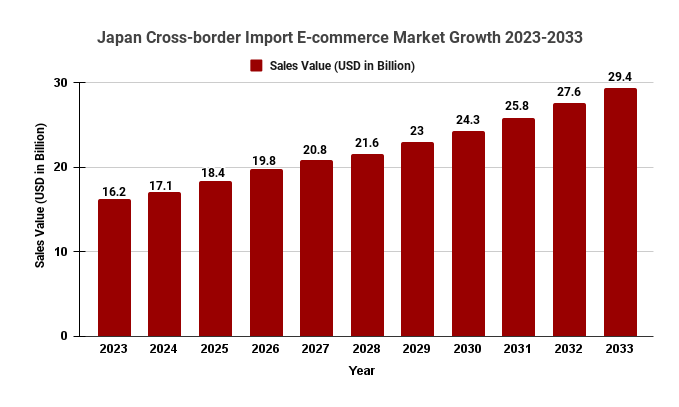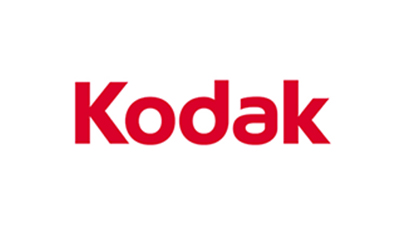
-
Report ID 137974 -
Published Date Mar 2023 -
Delivery Format PDF/PPT/Word -
Editor's Rating
-
Report Details
Market Overview
According to a report by TechMarketReports (Market.us), the Japan cross-border e-commerce market size was valued at USD 16.2 billion in 2023 and is projected to reach USD 29.4 billion by 2033, growing at a CAGR of 6.3% during the forecast period. The Japan cross-border import e-commerce market refers to the market for online shopping by Japanese consumers for products from foreign countries. The market includes both business-to-consumer (B2C) and consumer-to-consumer (C2C) transactions.
Cross-border import commerce e-commerce refers the international sale and purchase of goods via online platforms. This ecommerce allows you to import products from abroad to sell to your customers on the domestic market. Japan’s cross-border import E-commerce has gained popularity in recent years. Consumers are now more comfortable shopping online and want to get a wider range at cheaper prices. This has been made possible by improvements in technology, logistics, and payment systems. Businesses can now import and sell goods from abroad much more efficiently.

Japan is seeing an increase in popularity of online shopping. This is due to several factors, including ease, availability, and affordable prices. The Japanese demand for imported goods that are rare on the domestic marketplace is one of the major drivers of cross-border commerce in Japan. Because of their quality and unique designs, many Japanese buyers are interested to buy imported products from Europe or the United States. Japanese consumers have large disposable income, which makes them attractive buyers for companies that offer luxury or high-end products.
The largest market for Japan cross-border import e-commerce is China, followed by the United States and South Korea. The fastest-growing market is the United States, which is expected to experience significant growth due to the increasing demand for Japanese products among American consumers.
Demand Analysis
The demand for Japan cross-border import e-commerce is being driven by the increasing popularity of Japanese products among consumers around the world, particularly in Asia and North America. Japanese products are known for their high quality and unique features, such as design and innovation.
Top Key Trends
Some of the top key trends in the Japan cross-border import e-commerce market include the increasing adoption of mobile devices for online shopping, the use of social media and influencers for marketing, and the growing popularity of subscription-based services.
Top Impacting Factors
The key factors impacting the Japan cross-border import e-commerce market include the increasing demand for Japanese products among consumers around the world, the adoption of digital technologies for online shopping, and the growing importance of logistics and delivery services.Key Benefits for Stakeholders
The key benefits for stakeholders in the Japan cross-border import e-commerce market include the expansion of international trade and commerce, the promotion of Japanese products and culture to a global audience, and the improvement of logistics and delivery services.Market Dynamics
1. Drivers
The drivers of the Japan cross-border import e-commerce market include the increasing popularity of Japanese products among consumers around the world, the adoption of digital technologies for online shopping, and the growing importance of logistics and delivery services.
2. Restraints
The restraints of the Japan cross-border import e-commerce market include the challenges associated with cross-border logistics and delivery, the complexities of customs and tax regulations, and the risk of fraud and security breaches.
3. Opportunities
The opportunities in the Japan cross-border import e-commerce market include the adoption of technology for logistics and delivery services, the development of innovative payment and financing systems, and the expansion of e-commerce platforms and marketplaces.
4. Challenges
The challenges in the Japan cross-border import e-commerce market include the need to navigate complex customs and tax regulations, the risk of fraud and security breaches, and the need to build trust and credibility with consumers in foreign markets.
Key Companies & Market Share Insights
Zozo announced its intention to launch a cross-border ecommerce platform in 2023 in September 2022. It was intended to provide a limited number of Japanese goods to customers around the world. The initial focus of the platform will be on fashion and beauty products. It is expected that shipping will be available to over 200 countries around the world. These are some of the major players in Japan’s cross-border import e-commerce market.
- Amazon.com, Inc.
- Rakuten, Inc.
- Kakaku.com, Inc.
- Yahoo! Japan Corporation
- Apple Inc
- DMM.com, Ltd.
- YODOBASHI CAMERA CO., LTD
- Mercari, Inc.
- ZOZO, Inc.
- Qoo10 Pte. Ltd.
Report Segmentation
Platform Outlook (Revenue,2018-2033)
- B2B
- B2C
- C2C
- D2C
Merchant Size Outlook (Revenue, 2018-2033)
- Large Enterprises
- SME
Application Outlook (Revenue, 2018-2033)
- Food & Beverage
- Personal Care
- Furniture & Appliances
- Toys, Hobby & DIY
- Electronics & Media
- Fashion
- Others
Import Country Outlook
- U.S.
- China
- South Korea
- U.K.
- Italy
- Germany
- France
- Canada
- India
- Mexico
- Australia
- New Zealand
- Others
Report Scope
Report Attribute Details Forecast Years: 2023-2033 Historical Years: 2017-2022 Revenue 2023: USD 16.2 Bn Revenue 2033: USD 29.4 bn Revenue CAGR (2023 – 2033): 6.3% Fastest Growing Region United States Largest Region China Report Scope Market Trends, Drivers, and Restraints; Revenue Estimation and Forecast 2023-2033;
Segmentation Analysis; Impact of COVID-19; Companies’ Strategic Developments; Market Share Analysis of Key Players; Company ProfilingRegional Coverage & Country Coverage 5 Regions & Top 22 Countries - North America – (U.S., Canada, Mexico)
- Europe – (U.K., France, Germany, Italy, Spain, Rest Of Europe)
- Asia Pacific – (China, Japan, India, South Korea, South East Asia, Rest Of Asia Pacific)
- Latin America – (Brazil, Argentina, Rest Of Latin America)
- Middle East & Africa – (GCC Countries, South Africa, Rest Of Middle East & Africa)
Short-Term Projection Year 2028 Long-Term Projected Year 2033 Frequently Asked Questions About This Report
Here are some frequently asked questions about the Japan cross-border import e-commerce market:
1. What is the Japan cross-border import e-commerce market?
The Japan cross-border import e-commerce market refers to the market for online shopping by Japanese consumers for products from foreign countries. The market includes both business-to-consumer (B2C) and consumer-to-consumer (C2C) transactions.
2. What is the size of the Japan cross-border import e-commerce market?
The Japan cross-border e-commerce market size was valued at USD 16.2 billion in 2023 and is projected to reach USD 29.4 billion by 2028, growing at a CAGR of 6.3% during the forecast period.
3. What are the key drivers of the Japan cross-border import e-commerce market?
The key drivers of the Japan cross-border import e-commerce market include the increasing popularity of Japanese products among consumers around the world, the adoption of digital technologies for online shopping, and the growing importance of logistics and delivery services.4. What are the challenges facing the Japan cross-border import e-commerce market?
Some of the key challenges facing the Japan cross-border import e-commerce market include the need to navigate complex customs and tax regulations, the risk of fraud and security breaches, and the need to build trust and credibility with consumers in foreign markets. -
Table Of Content
Research Insights & Deliverables
 Development and Future Forecast
Development and Future Forecast Competitive benchmarking
Competitive benchmarking Company Revenue Statistics
Company Revenue Statistics Rising Regional Opportunities
Rising Regional Opportunities Technology Trends and Dynamics
Technology Trends and Dynamics Technology Assessment
Technology Assessment
-
Inquiry Before Buying
Research Insights & Deliverables
 Development and Future Forecast
Development and Future Forecast Competitive benchmarking
Competitive benchmarking Company Revenue Statistics
Company Revenue Statistics Rising Regional Opportunities
Rising Regional Opportunities Technology Trends and Dynamics
Technology Trends and Dynamics Technology Assessment
Technology Assessment
-
Request Sample
Research Insights & Deliverables
 Development and Future Forecast
Development and Future Forecast Competitive benchmarking
Competitive benchmarking Company Revenue Statistics
Company Revenue Statistics Rising Regional Opportunities
Rising Regional Opportunities Technology Trends and Dynamics
Technology Trends and Dynamics Technology Assessment
Technology Assessment














